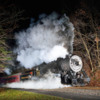I don't like to see any more smoke than is necessary. I like to see the engines run efficiently, like they would have been when they were actually in revenue service. While we're at it, I don't like any more whistle than is necessary either. I like to watch, and listen to the machinery of the engine working properly. Unnecessary use of the whistle is actually a rule violation. I think it's embarrassing to me as a retired engineer, to see somebody laying on the whistle, trying to be an "artist" during a run by, when there is not a grade crossing around for miles, completely drowning out the sound of the engine, the rods, and the train. Keep it real, we didn't buy a ticket and ride the train just to listen to the whistle being blown for the sake of making noise. (rant over)
Well sir, you just might be the ONLY paying passenger on any/all of the various main line steam excursions throughout the United States that DOES NOT WANT TO HEAR THE WHISTLE during a photo run-by!
I can remember quite some years ago, performing a photo run with SP 4449. Since I already knew we were going to perform TWO run-by for the passenger on the train, I suggested that we NOT use the whistle (except for the start of forward movement) and NOT make any smoke! The crowd was not fully aware that we were going to perform two run-by, so before the first run-by was even over, we were getting the gestures from some of the people to "blow the whistle", and more than one comment came over the radio about "What happened to the smoke???", even though we had 4449 "down in the corner" at full throttle, and a bit of air set in the passenger train.
Naturally, the second run-by was with whistling and noticeable smoke during another full throttle pass. Needless to say, we never tried THAT, i.e. no whistle and no smoke, operation again!










